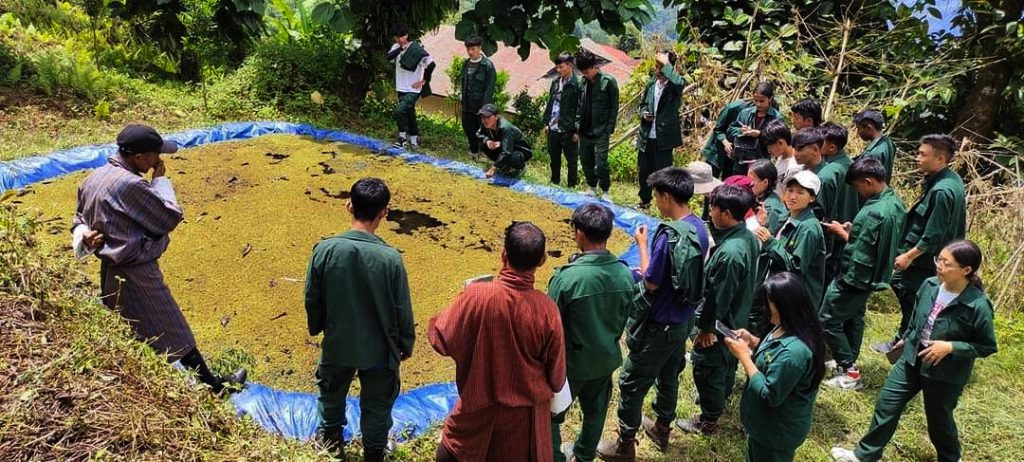….𝒑𝒆𝒐𝒑𝒍𝒆 𝒉𝒂𝒗𝒆 𝒃𝒆𝒆𝒏 𝒂𝒃𝒍𝒆 𝒕𝒐 𝒈𝒓𝒐𝒘 𝒗𝒆𝒈𝒆𝒕𝒂𝒃𝒍𝒆𝒔 𝒆𝒗𝒆𝒏 𝒅𝒖𝒓𝒊𝒏𝒈 𝒕𝒉𝒆 𝒅𝒓𝒚 𝒔𝒆𝒂𝒔𝒐𝒏 𝒃𝒆𝒄𝒂𝒖𝒔𝒆 𝒐𝒇 𝒘𝒂𝒕𝒆𝒓 𝒉𝒂𝒓𝒗𝒆𝒔𝒕𝒊𝒏𝒈
Sonam Choki
Water harvesting has been practiced by farmers in Tsirang Toed for the past two years. People have been able to grow even during the dry season because of water harvesting. While, some two years ago people were facing water shortages, they are now seeing a greener pasture.
“Long-term water scarcity in our neighborhood has been solved by water harvesting. Even if we were interested in farming, there wasn’t much to do until water harvesting. Today, we grow cardamom, bananas, and cabbage for market. We see a bright future with water harvesting”, said Ratna Badhur, a farmer of Tsirang.
Lal Bir Rai, a farmer said, “Water harvesting has been greatly beneficial in enhancing commercial farming. I can retain my household needs all year round. My family does not have to worry about having to work early in the morning to fetch water for farming. In the past we had to worry about not having enough water and had to wake up midnight to get water for irrigation and drinking purposes. During dry season we had no work to do and had to depend mostly on dried vegetables. But now with the low-cost plastic-lined water harvesting pond technology we can store rainwater or runoff water and use it anytime we want”.
As per Toed Gup, Nanda Lal Kharel, the geog has been greatly benefitted through water harvesting and in fact water harvesting technology is one of the many ways technologies that have enhanced the geogs agriculture production.
“The water farming has considerably benefited the people of the geog. It is a new knowledge to the farmers, it has helped in generating extra income and through the Agriculture Land Development (ALD), and farmers have converted unused land to making ponds for water harvesting. Even throughout the dry season, farmers have been able to grow veggies. Before, when we did not have water harvesting we had to depend mostly on dried vegetables but now with water harvesting in place, the community has green and fresh vegetables all year round”, he said.
Sonam Dorji, Sr. Extension supervisor, Mendrelgang Gewog said, “We have 15 numbers of rain water harvesting ponds at the farmers’ fields. The gewog supplied and installed silpaulin sheet for rainwater harvesting supported through Dzongkhag Agriculture sector. Mendrelgang Gewog is one of the commercial vegetable grown areas. With the introduction of rain harvesting pond, farmers have increased areas and productions.”
Like many other rural regions in Bhutan, Tsirang Toed store water in a pond dug in an empty land and a tarpaulin sheet is laid inside to stop water from sipping into the ground. Rainwater is the main source through which water is stored in the pond. Perennial water source is also connected to the pond in order to not let the water dry. The source not only helps in filling the pond but also helps in not letting the pond dry up. From there a tunnel is dug for water outlet and hence used for agriculture purpose.
Dorji Gyeltshen, Dy. Chief Dzongkhag Agriculture Officer, Tsirang Dzongkha said that the dzongkhg initiated water harvesting program since 2018 covering almost all the Geogs. “Harvested water is used right after monsoon until the onset of next monsoon but mainly for winter vegetable farming. Water is used for vegetables, fruits and raising paddy nursery”, said Dorji Gyeltshen.
“The office supports with pipes, reservoir (sintex) or silpauline/plastic sheet to build water reservoir to harvest water. The water is harvested mainly from rain and channeled roof water”, he added.
Krishna Lal Sanyasi, a farmer of Phuentenchu said that the water harvest project has benefited in many different ways as they have scarcity of water and the harvested water can be used as and when needed for growing vegetables.
“The only thing that concerns me was that it has a very high risk of drowning our children and animals and so, fence the pool with chain-link”, said Krishna.
Sangay Wangdi, Sr. Extension Supervisor of Phuentenchu gewog said, “In consultation with Chewog Tsogpa and Gewog Officials (Gup/ Mangmi), they identify progressive/potential vegetable growers among group members or individual farming farmers and as per the availability of budget or resources, the inputs are issued to the farmers “.
“Moreover the farmers are encouraged to take up or adopt new technologies through various extension approaches such as conducting awareness programs, training and demonstration”, he added.
The farmers grow spinach, chili, radish and cauliflower among other vegetables during the dry season. For the next coming years the village hopes to see 100% water harvesting in the community. Currently, there are 230 farmers in Tsirang using water-harvesting technology.

 BHUTAN TODAY The New Perspective
BHUTAN TODAY The New Perspective
